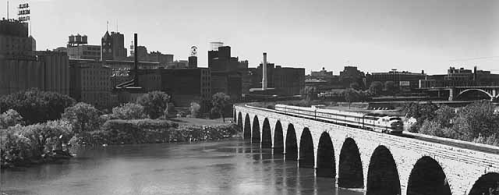Kid Cann: The Kingpin of Minneapolis
 Monday, July 13, 2020 at 3:45AM |
Monday, July 13, 2020 at 3:45AM |  Michael Rainville Jr |
Michael Rainville Jr | Article by Michael Rainville, Jr.
September 8th, 1900, Râmnicu Sărat, Romania. Eva Blumenfeld and her husband Phillip welcome their first born, Isadore, into the world. Two years later, the young family packed their bags and set sail for America. Eventually landing in Duluth, the Blumenfelds settled in North Minneapolis in 1902, and the rest is history.
 Isadore Blumenfeld a.k.a. Kid CannGrowing up in Cedar Riverside and Near North, Isadore and his family bounced from house to house as his parents tried to make ends meet. At fifteen, Isadore dropped out of school for the last time and picked up a gig as a paper boy on Newspaper Row in Minneapolis in order to help his parents financially support his two younger brothers. After using his charm, wit, and persistence, he rose the ranks and eventually acquired the paper routes that went through the wealthier areas of town.
Isadore Blumenfeld a.k.a. Kid CannGrowing up in Cedar Riverside and Near North, Isadore and his family bounced from house to house as his parents tried to make ends meet. At fifteen, Isadore dropped out of school for the last time and picked up a gig as a paper boy on Newspaper Row in Minneapolis in order to help his parents financially support his two younger brothers. After using his charm, wit, and persistence, he rose the ranks and eventually acquired the paper routes that went through the wealthier areas of town.
The older he grew, the bolder he became with his moneymaking schemes. The first time he was arrested came in 1920, at nineteen-years-old, for being in a “disorderly house,” probably for partying too loud. One month later, he was caught pickpocketing outside of the Armory during a Norwegian church event. Three years later, some of Isadore’s acquaintances were involved in a deadly bank robbery in St. Paul. When the police tracked down the getaway car, they found it parked in front of a familiar house. The only two people inside were not directly involved with the robbery and murder, but because of an already notorious reputation, Isadore and his friend James Pierce were arrested. Isadore was eventually acquitted, but when the police booked him, he gave them the name “Harry Bloom” one of his many aliases.
In April of 1924, Isadore Blumenfeld was once again making headlines when he shot and paralyzed Charles Goldberg in front of the Vienna Café on Nicollet Avenue. As the story goes, Isadore, his friend Robert Royan, and a cab driver Abe Percansky were arguing over a woman. Punches started being thrown and a crowd quickly grew. The cab driver pulled out a gun since he was outnumbered, and Isadore immediately took it from him. In the midst of the scuffle he shot Charles Goldberg, a bystander who was trying to break up the fight. The bullet severed Charles’ spine, and he was paralyzed from the chest down. While giving his statement to the police at the hospital, he said he was only trying to calm everyone down and that it was all an accident. After slipping into a coma, Charles succumbed to his injuries nine days later.
Isadore admitted to the shooting, but he had a friend in the legal world. Growing up in the same area of North Minneapolis as Isadore and other eventual gangsters, Floyd B. Olson was in the middle of his second term as Hennepin County Attorney. The murder was ruled an accident and Isadore did not have to serve any time.
At some point during his late teens and early twenties, Isadore earned the nickname Kid Cann. He claims he earned it in the boxing ring, but other say it was because he could always be found sitting on the can when crimes and murders he was associated with took place. He adamantly denied that explanation, so that means it was probably true, right?
Kid Cann and his bothers ventured into the bootlegging business in the 1920s. Supplied with whiskey from Canada, rum from Louisiana, and moonshine from stills in Stearns County and in a forest near Fort Snelling, Kid Cann became the king of liquor in the Twin Cities and upper Midwest. Doc Ames, a former four-time mayor of Minneapolis, can be partially credited with Kid Cann’s success. When he was in office during the turn of the 20th century, he fired over half of the police force, appointed his own brother as chief of police, hired an infamous gambler to be the new chief of detectives, and replaced the fired officers with criminals and gangsters. Operating in a city where politicians and the police force backed his business, Kid Cann would frequently supply Al Capone’s Chicago Outfit with illegal booze. Once prohibition ended in December of 1933, Kid Cann and his brothers bribed and conned their way through city hall once again and became extremely influential with distributing liquor licenses in Minneapolis.
During the peak of the Gangster Era in the United States, the Twin Cities was full of corruption and crime. St. Paul’s long line of crooked police chiefs meant St. Paul was a sanctuary for gangs, such as the Barker-Karpis Gang, and Minneapolis was being run by Kid Cann. Fortunately, this meant that not too many gangs wanted to step on Cann’s toes and mess with his territory.
Kid Cann pushed his luck in other states as well. He was caught transporting Cuban rum in Louisiana, but never showed up to his court date and charges were dropped. Two years later in 1933, he was charged with laundering the $200,000 ransom ‘Machine Gun’ Kelly received from kidnapping an oil business owner. The federal government traced the money to Hennepin State Bank in Minneapolis, took him in for questioning, and transported him to Oklahoma City where the kidnapping took place to await the trial. Kid Cann used his influence yet again when Minneapolis Police Chief Joseph Lehmeyer traveled down to Oklahoma City to testify in favor of Kid Cann. Cann’s charges were dropped.
 1936 photo of Kid Cann and his legal team smiling after he was acquitted of the murder of journalist Walter Liggett.
1936 photo of Kid Cann and his legal team smiling after he was acquitted of the murder of journalist Walter Liggett.
 Headline about that acquittal.
Headline about that acquittal.
One of Kid Cann’s more infamous crimes was the murder of former New York Times writer and investigative journalist Walter Liggett outside his home in Minneapolis. Liggett was making waves in the Twin Cities journalism scene by exposing crooked cops and politicians, including many articles on the corruption of former Hennepin County Attorney and governor of Minnesota at the time, Floyd B. Olson. As brave it is to call out politicians on obvious corruption, Liggett’s fate was sealed. He was shot five times in the back. As her husband’s murderer drove off, Edith got a glimpse of his face and was convinced it was a smiling Kid Cann. All it took for Kid Cann to be acquitted of all charges was an alibi from his barber. Even though her husband’s killer, whoever it was, was never convicted, she insisted Governor Olson played a roll in the hit.
Kid Cann’s last major Minneapolis crime came in the early 1950s when busses were replacing streetcars. As a holder of 16% of the Twin City Rapid Transit Company and part-owner of Mid-Continent Development & Construction, Kid Cann caused the downfall of one of the best streetcar systems in the nation. Kid Cann and others convinced the company that diesel busses were the up-and-coming, preferred mode of transportation that would usher in a new, successful age for the city. Cables and tracks were uninstalled and sold to two companies for a fraction of their value. One of those companies was Kid Cann’s Mid-Continent Development & Construction. To no one’s surprise, it took many years for the authorities to uncover what he did, and he was acquitted of all charges.
 Kid Cann's grave marker
Kid Cann's grave marker
After serving five years of prison time for transporting a prostitute across state lines, he was ordered to never live in Minneapolis again. He did not seem too upset and moved down to Miami and went into business with famous mobster Meyer Lansky. Even though the court ordered him to never live in Minneapolis, he still frequently visited his family and friends multiple times a year. He never made headlines again until his last trip back to Minneapolis in 1981 when he died of heart disease at Mt. Sinai Hospital at the age of eighty. There are many stories and tall tales of Kid Cann, but his life is still a mystery. To put it in his own words, “ninety percent of what was written about me is bull[crap].”
- - - - - - - - - - - - - - - - - - - - - - - - - -
 About Michael Rainville, Jr.
About Michael Rainville, Jr.
A 6th generation Minneapolitan, Michael Rainville Jr. received his B.A. in History from the University of St. Thomas, and is currently enrolled in their M.A. in Art History and Certificate in Museum Studies programs. Michael is also a historic interpreter and guide at Historic Fort Snelling at Bdote and a lead guide at Mobile Entertainment LLC, giving Segway tours of the Minneapolis riverfront for 7+ years. Contact: mrainvillejr@comcast.net. Click here for an interactive map of Michael's past articles.










































































 He was also very fond of the Minneapolis Park system and intended to give his property to the Minneapolis Park Board once he passed away. In 1911, the property immediately south of his estate, the Villa Rosa owned by Dorilus Morrison, the first mayor of Minneapolis, was donated by Morrison’s son to the city with the intention to build an art museum on the site. Eventually, the Villa Rosa made way for the Minneapolis Institute of Art. This gave William Washburn the idea to offer his land to the Park Board. The deal was that the city would only pay the appraised amount of the land, and not the land and its buildings. This was a huge deal because Washburn’s buildings were valued at roughly $400,000, or over $10.5 million in today’s dollars. He sold the land to the Park Board for $250,000, or $6.6 million today, with the condition that he and his wife could reside there for as long as they lived. The land officially changed hands in 1915 when his wife passed away.
He was also very fond of the Minneapolis Park system and intended to give his property to the Minneapolis Park Board once he passed away. In 1911, the property immediately south of his estate, the Villa Rosa owned by Dorilus Morrison, the first mayor of Minneapolis, was donated by Morrison’s son to the city with the intention to build an art museum on the site. Eventually, the Villa Rosa made way for the Minneapolis Institute of Art. This gave William Washburn the idea to offer his land to the Park Board. The deal was that the city would only pay the appraised amount of the land, and not the land and its buildings. This was a huge deal because Washburn’s buildings were valued at roughly $400,000, or over $10.5 million in today’s dollars. He sold the land to the Park Board for $250,000, or $6.6 million today, with the condition that he and his wife could reside there for as long as they lived. The land officially changed hands in 1915 when his wife passed away.

